Assessing Motivation Theories: A Report for BA3UK32O Module, 2021-2022
VerifiedAdded on 2023/06/11
|7
|1899
|442
Report
AI Summary
This report provides a comprehensive overview of various motivation theories and their practical applications in the workplace. It begins with an introduction to motivation, highlighting its importance in achieving organizational goals and objectives. The report then delves into several key theories, including Maslow's Hierarchy of Needs, Alderfer's ERG theory, Herzberg's Two-Factor Theory, McGregor's X and Y theory, and McClelland's Theory of Needs. Each theory is explained in detail, with examples of how it can be applied to enhance employee motivation and improve performance. The report emphasizes the importance of understanding employee needs and tailoring motivational strategies accordingly. It also discusses how these theories can be used to manage employee satisfaction, reduce turnover, and increase overall efficiency within an organization. The report also includes a discussion on the application of these theories in the modern workplace, and provides references to relevant academic literature.
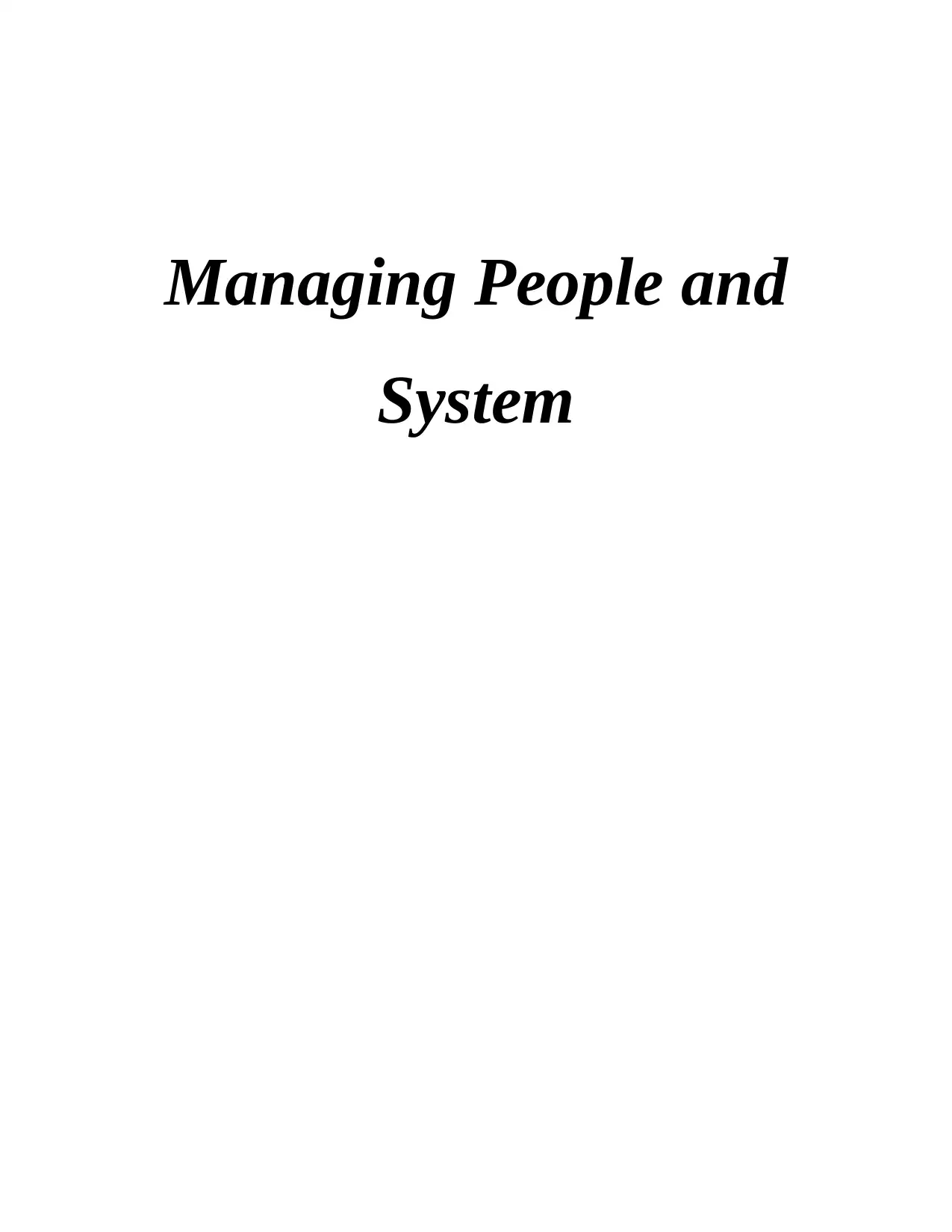
Managing People and
System
System
Paraphrase This Document
Need a fresh take? Get an instant paraphrase of this document with our AI Paraphraser

Contents
Contents...........................................................................................................................................2
INTRODUCTION...........................................................................................................................1
REFERENCES................................................................................................................................1
Contents...........................................................................................................................................2
INTRODUCTION...........................................................................................................................1
REFERENCES................................................................................................................................1
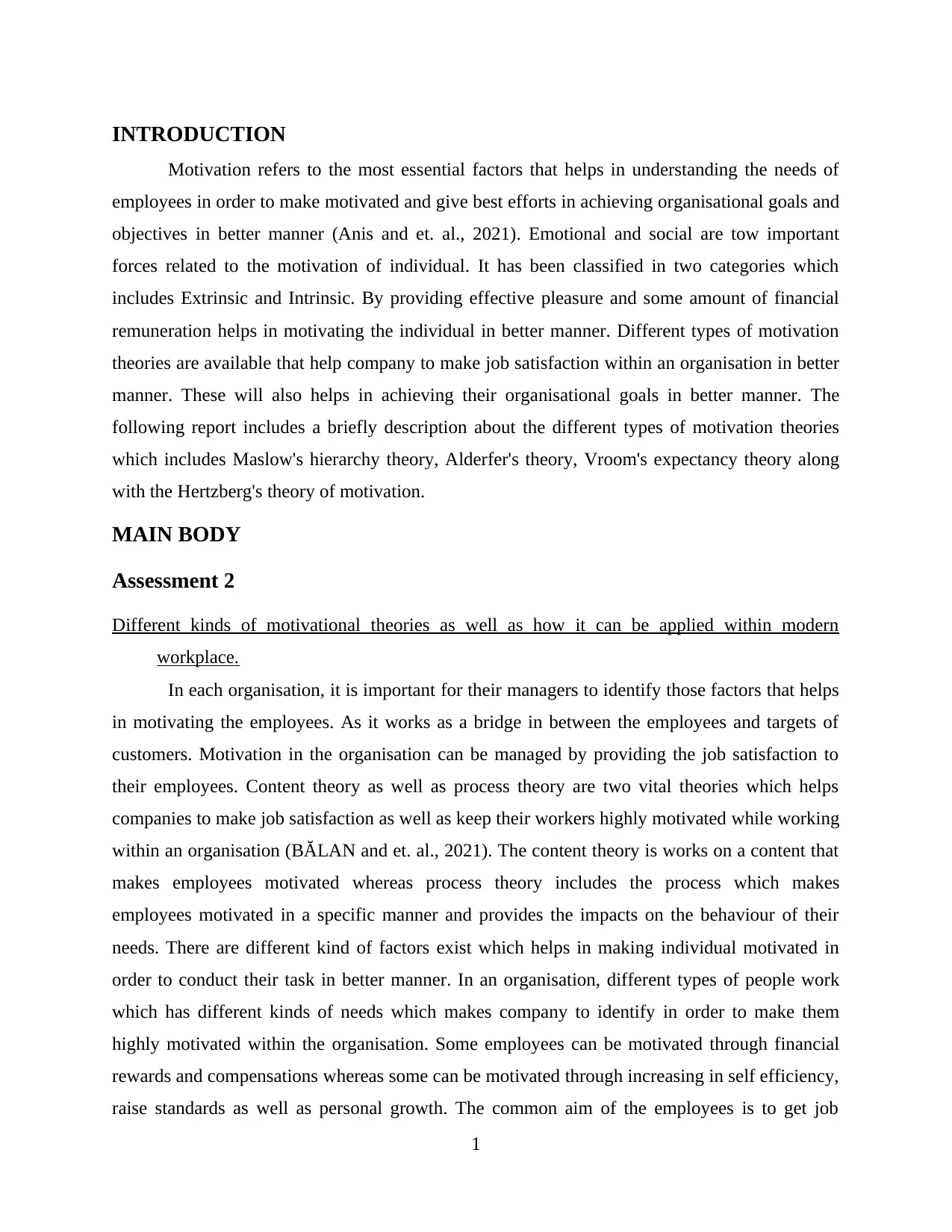
INTRODUCTION
Motivation refers to the most essential factors that helps in understanding the needs of
employees in order to make motivated and give best efforts in achieving organisational goals and
objectives in better manner (Anis and et. al., 2021). Emotional and social are tow important
forces related to the motivation of individual. It has been classified in two categories which
includes Extrinsic and Intrinsic. By providing effective pleasure and some amount of financial
remuneration helps in motivating the individual in better manner. Different types of motivation
theories are available that help company to make job satisfaction within an organisation in better
manner. These will also helps in achieving their organisational goals in better manner. The
following report includes a briefly description about the different types of motivation theories
which includes Maslow's hierarchy theory, Alderfer's theory, Vroom's expectancy theory along
with the Hertzberg's theory of motivation.
MAIN BODY
Assessment 2
Different kinds of motivational theories as well as how it can be applied within modern
workplace.
In each organisation, it is important for their managers to identify those factors that helps
in motivating the employees. As it works as a bridge in between the employees and targets of
customers. Motivation in the organisation can be managed by providing the job satisfaction to
their employees. Content theory as well as process theory are two vital theories which helps
companies to make job satisfaction as well as keep their workers highly motivated while working
within an organisation (BĂLAN and et. al., 2021). The content theory is works on a content that
makes employees motivated whereas process theory includes the process which makes
employees motivated in a specific manner and provides the impacts on the behaviour of their
needs. There are different kind of factors exist which helps in making individual motivated in
order to conduct their task in better manner. In an organisation, different types of people work
which has different kinds of needs which makes company to identify in order to make them
highly motivated within the organisation. Some employees can be motivated through financial
rewards and compensations whereas some can be motivated through increasing in self efficiency,
raise standards as well as personal growth. The common aim of the employees is to get job
1
Motivation refers to the most essential factors that helps in understanding the needs of
employees in order to make motivated and give best efforts in achieving organisational goals and
objectives in better manner (Anis and et. al., 2021). Emotional and social are tow important
forces related to the motivation of individual. It has been classified in two categories which
includes Extrinsic and Intrinsic. By providing effective pleasure and some amount of financial
remuneration helps in motivating the individual in better manner. Different types of motivation
theories are available that help company to make job satisfaction within an organisation in better
manner. These will also helps in achieving their organisational goals in better manner. The
following report includes a briefly description about the different types of motivation theories
which includes Maslow's hierarchy theory, Alderfer's theory, Vroom's expectancy theory along
with the Hertzberg's theory of motivation.
MAIN BODY
Assessment 2
Different kinds of motivational theories as well as how it can be applied within modern
workplace.
In each organisation, it is important for their managers to identify those factors that helps
in motivating the employees. As it works as a bridge in between the employees and targets of
customers. Motivation in the organisation can be managed by providing the job satisfaction to
their employees. Content theory as well as process theory are two vital theories which helps
companies to make job satisfaction as well as keep their workers highly motivated while working
within an organisation (BĂLAN and et. al., 2021). The content theory is works on a content that
makes employees motivated whereas process theory includes the process which makes
employees motivated in a specific manner and provides the impacts on the behaviour of their
needs. There are different kind of factors exist which helps in making individual motivated in
order to conduct their task in better manner. In an organisation, different types of people work
which has different kinds of needs which makes company to identify in order to make them
highly motivated within the organisation. Some employees can be motivated through financial
rewards and compensations whereas some can be motivated through increasing in self efficiency,
raise standards as well as personal growth. The common aim of the employees is to get job
1
⊘ This is a preview!⊘
Do you want full access?
Subscribe today to unlock all pages.

Trusted by 1+ million students worldwide
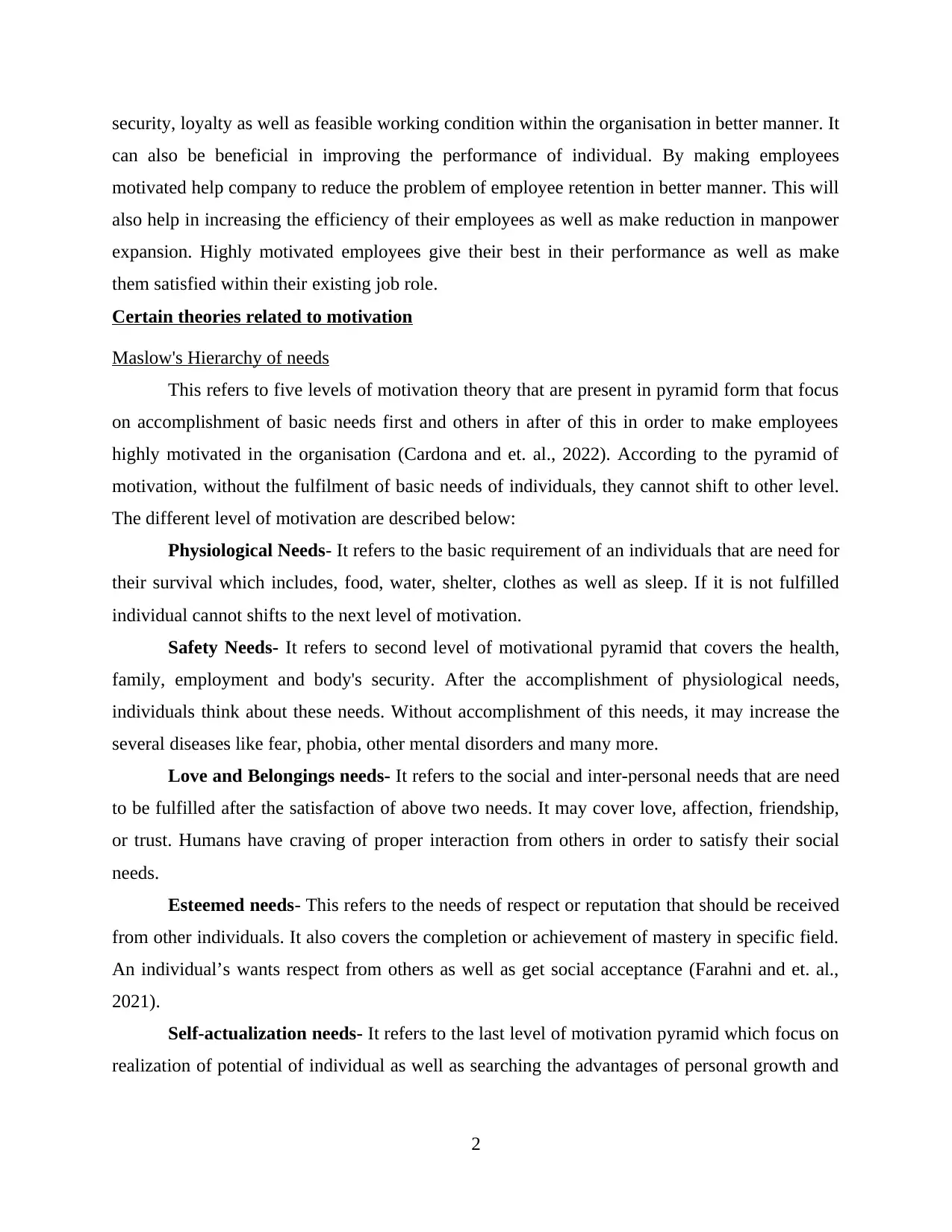
security, loyalty as well as feasible working condition within the organisation in better manner. It
can also be beneficial in improving the performance of individual. By making employees
motivated help company to reduce the problem of employee retention in better manner. This will
also help in increasing the efficiency of their employees as well as make reduction in manpower
expansion. Highly motivated employees give their best in their performance as well as make
them satisfied within their existing job role.
Certain theories related to motivation
Maslow's Hierarchy of needs
This refers to five levels of motivation theory that are present in pyramid form that focus
on accomplishment of basic needs first and others in after of this in order to make employees
highly motivated in the organisation (Cardona and et. al., 2022). According to the pyramid of
motivation, without the fulfilment of basic needs of individuals, they cannot shift to other level.
The different level of motivation are described below:
Physiological Needs- It refers to the basic requirement of an individuals that are need for
their survival which includes, food, water, shelter, clothes as well as sleep. If it is not fulfilled
individual cannot shifts to the next level of motivation.
Safety Needs- It refers to second level of motivational pyramid that covers the health,
family, employment and body's security. After the accomplishment of physiological needs,
individuals think about these needs. Without accomplishment of this needs, it may increase the
several diseases like fear, phobia, other mental disorders and many more.
Love and Belongings needs- It refers to the social and inter-personal needs that are need
to be fulfilled after the satisfaction of above two needs. It may cover love, affection, friendship,
or trust. Humans have craving of proper interaction from others in order to satisfy their social
needs.
Esteemed needs- This refers to the needs of respect or reputation that should be received
from other individuals. It also covers the completion or achievement of mastery in specific field.
An individual’s wants respect from others as well as get social acceptance (Farahni and et. al.,
2021).
Self-actualization needs- It refers to the last level of motivation pyramid which focus on
realization of potential of individual as well as searching the advantages of personal growth and
2
can also be beneficial in improving the performance of individual. By making employees
motivated help company to reduce the problem of employee retention in better manner. This will
also help in increasing the efficiency of their employees as well as make reduction in manpower
expansion. Highly motivated employees give their best in their performance as well as make
them satisfied within their existing job role.
Certain theories related to motivation
Maslow's Hierarchy of needs
This refers to five levels of motivation theory that are present in pyramid form that focus
on accomplishment of basic needs first and others in after of this in order to make employees
highly motivated in the organisation (Cardona and et. al., 2022). According to the pyramid of
motivation, without the fulfilment of basic needs of individuals, they cannot shift to other level.
The different level of motivation are described below:
Physiological Needs- It refers to the basic requirement of an individuals that are need for
their survival which includes, food, water, shelter, clothes as well as sleep. If it is not fulfilled
individual cannot shifts to the next level of motivation.
Safety Needs- It refers to second level of motivational pyramid that covers the health,
family, employment and body's security. After the accomplishment of physiological needs,
individuals think about these needs. Without accomplishment of this needs, it may increase the
several diseases like fear, phobia, other mental disorders and many more.
Love and Belongings needs- It refers to the social and inter-personal needs that are need
to be fulfilled after the satisfaction of above two needs. It may cover love, affection, friendship,
or trust. Humans have craving of proper interaction from others in order to satisfy their social
needs.
Esteemed needs- This refers to the needs of respect or reputation that should be received
from other individuals. It also covers the completion or achievement of mastery in specific field.
An individual’s wants respect from others as well as get social acceptance (Farahni and et. al.,
2021).
Self-actualization needs- It refers to the last level of motivation pyramid which focus on
realization of potential of individual as well as searching the advantages of personal growth and
2
Paraphrase This Document
Need a fresh take? Get an instant paraphrase of this document with our AI Paraphraser
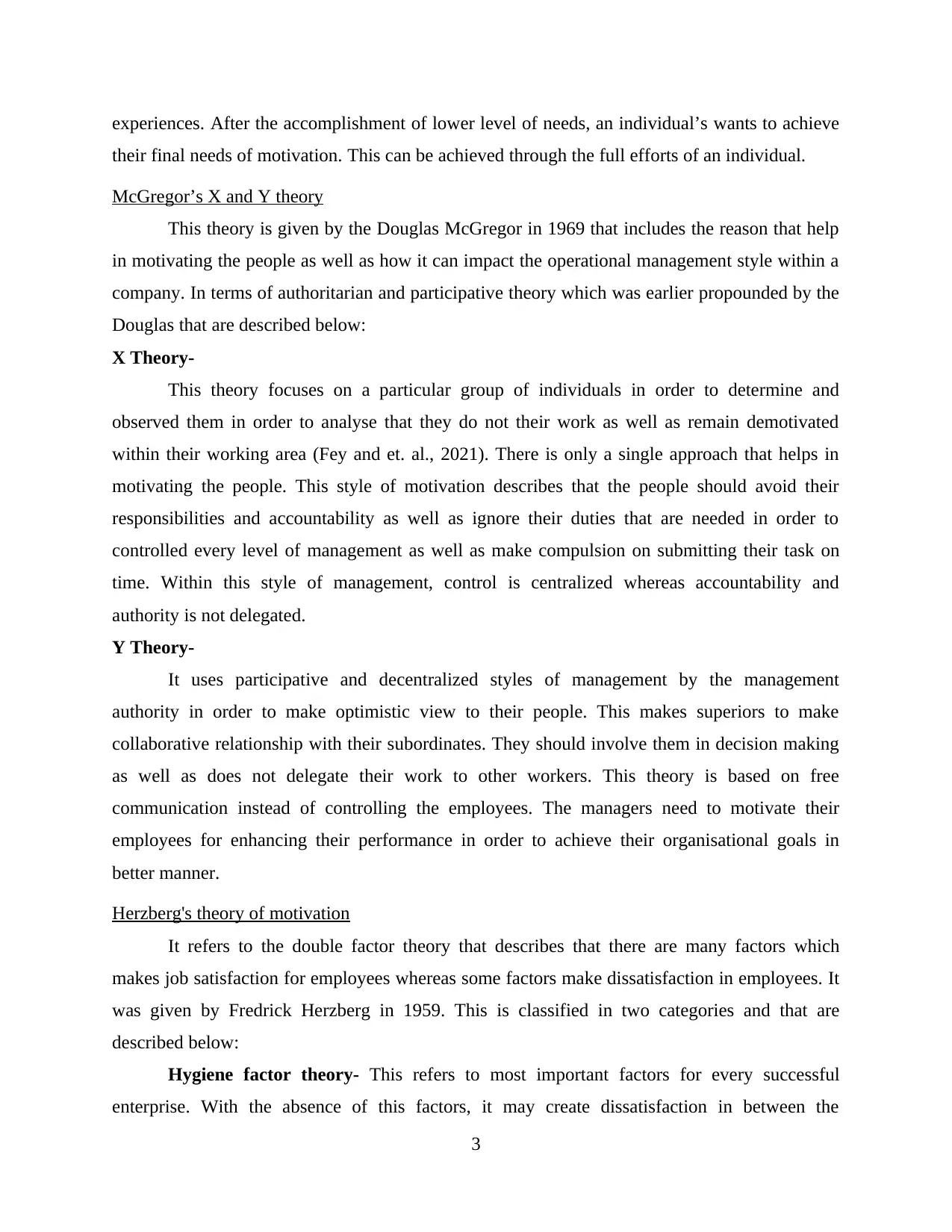
experiences. After the accomplishment of lower level of needs, an individual’s wants to achieve
their final needs of motivation. This can be achieved through the full efforts of an individual.
McGregor’s X and Y theory
This theory is given by the Douglas McGregor in 1969 that includes the reason that help
in motivating the people as well as how it can impact the operational management style within a
company. In terms of authoritarian and participative theory which was earlier propounded by the
Douglas that are described below:
X Theory-
This theory focuses on a particular group of individuals in order to determine and
observed them in order to analyse that they do not their work as well as remain demotivated
within their working area (Fey and et. al., 2021). There is only a single approach that helps in
motivating the people. This style of motivation describes that the people should avoid their
responsibilities and accountability as well as ignore their duties that are needed in order to
controlled every level of management as well as make compulsion on submitting their task on
time. Within this style of management, control is centralized whereas accountability and
authority is not delegated.
Y Theory-
It uses participative and decentralized styles of management by the management
authority in order to make optimistic view to their people. This makes superiors to make
collaborative relationship with their subordinates. They should involve them in decision making
as well as does not delegate their work to other workers. This theory is based on free
communication instead of controlling the employees. The managers need to motivate their
employees for enhancing their performance in order to achieve their organisational goals in
better manner.
Herzberg's theory of motivation
It refers to the double factor theory that describes that there are many factors which
makes job satisfaction for employees whereas some factors make dissatisfaction in employees. It
was given by Fredrick Herzberg in 1959. This is classified in two categories and that are
described below:
Hygiene factor theory- This refers to most important factors for every successful
enterprise. With the absence of this factors, it may create dissatisfaction in between the
3
their final needs of motivation. This can be achieved through the full efforts of an individual.
McGregor’s X and Y theory
This theory is given by the Douglas McGregor in 1969 that includes the reason that help
in motivating the people as well as how it can impact the operational management style within a
company. In terms of authoritarian and participative theory which was earlier propounded by the
Douglas that are described below:
X Theory-
This theory focuses on a particular group of individuals in order to determine and
observed them in order to analyse that they do not their work as well as remain demotivated
within their working area (Fey and et. al., 2021). There is only a single approach that helps in
motivating the people. This style of motivation describes that the people should avoid their
responsibilities and accountability as well as ignore their duties that are needed in order to
controlled every level of management as well as make compulsion on submitting their task on
time. Within this style of management, control is centralized whereas accountability and
authority is not delegated.
Y Theory-
It uses participative and decentralized styles of management by the management
authority in order to make optimistic view to their people. This makes superiors to make
collaborative relationship with their subordinates. They should involve them in decision making
as well as does not delegate their work to other workers. This theory is based on free
communication instead of controlling the employees. The managers need to motivate their
employees for enhancing their performance in order to achieve their organisational goals in
better manner.
Herzberg's theory of motivation
It refers to the double factor theory that describes that there are many factors which
makes job satisfaction for employees whereas some factors make dissatisfaction in employees. It
was given by Fredrick Herzberg in 1959. This is classified in two categories and that are
described below:
Hygiene factor theory- This refers to most important factors for every successful
enterprise. With the absence of this factors, it may create dissatisfaction in between the
3

employees. With the availability of this factors in the organisation leads job satisfaction in
between the employees. It covers some crucial factors that are described below: Policies- This makes the policies of the company should be formulated in proper along
with the clear objectives as well as features like dress code of employees, working
hours,etc. Salary Structure- The company need to provide adequate amount of salary to their
employees as compared with their competitors. This will help in making the job
satisfaction in between the employees in better manner.
Other benefits- The employees should also be provided some fringe benefits from their
employers which includes accidental and health insurance along with the life insurance
policies.
Motivational factors- The proper job satisfaction in between the employees can not only
be achieved by the hygiene factors only. This makes company to determine certain motivational
factors that helps in making employees motivates in order to feel highly satisfied. There are some
more benefits apart from the psychological needs of motivation (McGough and et. al., 2021).
These factors help in improving the performance of the employees with the help of motivation
and rewarding. The motivational factors are described below: Promotional opportunities- It covers the promotional and growth opportunities for the
employees in order to make employees highly motivated in order to perform well as well
as enhance their career levels. Responsibility- This makes employees need to be free for their work. The management
of an organisation need to ensures that there will be a minimum control on each
employee but covers complete proper accountability towards his work.
Meaningful of Work- For motivating an employee, management should provide them
meaningful work. Meaning less and unusual work makes their employees demotivated
and they cannot perform their task in proper manner.
McClelland's theory of needs
This theory was given by the David McClellands which states that the human behaviour
can be influenced by the three needs that covers power, achievement and affiliation. It can be
achieved through life experiences as well as ethos. It was classified in three categories that are
described below:
4
between the employees. It covers some crucial factors that are described below: Policies- This makes the policies of the company should be formulated in proper along
with the clear objectives as well as features like dress code of employees, working
hours,etc. Salary Structure- The company need to provide adequate amount of salary to their
employees as compared with their competitors. This will help in making the job
satisfaction in between the employees in better manner.
Other benefits- The employees should also be provided some fringe benefits from their
employers which includes accidental and health insurance along with the life insurance
policies.
Motivational factors- The proper job satisfaction in between the employees can not only
be achieved by the hygiene factors only. This makes company to determine certain motivational
factors that helps in making employees motivates in order to feel highly satisfied. There are some
more benefits apart from the psychological needs of motivation (McGough and et. al., 2021).
These factors help in improving the performance of the employees with the help of motivation
and rewarding. The motivational factors are described below: Promotional opportunities- It covers the promotional and growth opportunities for the
employees in order to make employees highly motivated in order to perform well as well
as enhance their career levels. Responsibility- This makes employees need to be free for their work. The management
of an organisation need to ensures that there will be a minimum control on each
employee but covers complete proper accountability towards his work.
Meaningful of Work- For motivating an employee, management should provide them
meaningful work. Meaning less and unusual work makes their employees demotivated
and they cannot perform their task in proper manner.
McClelland's theory of needs
This theory was given by the David McClellands which states that the human behaviour
can be influenced by the three needs that covers power, achievement and affiliation. It can be
achieved through life experiences as well as ethos. It was classified in three categories that are
described below:
4
⊘ This is a preview!⊘
Do you want full access?
Subscribe today to unlock all pages.

Trusted by 1+ million students worldwide
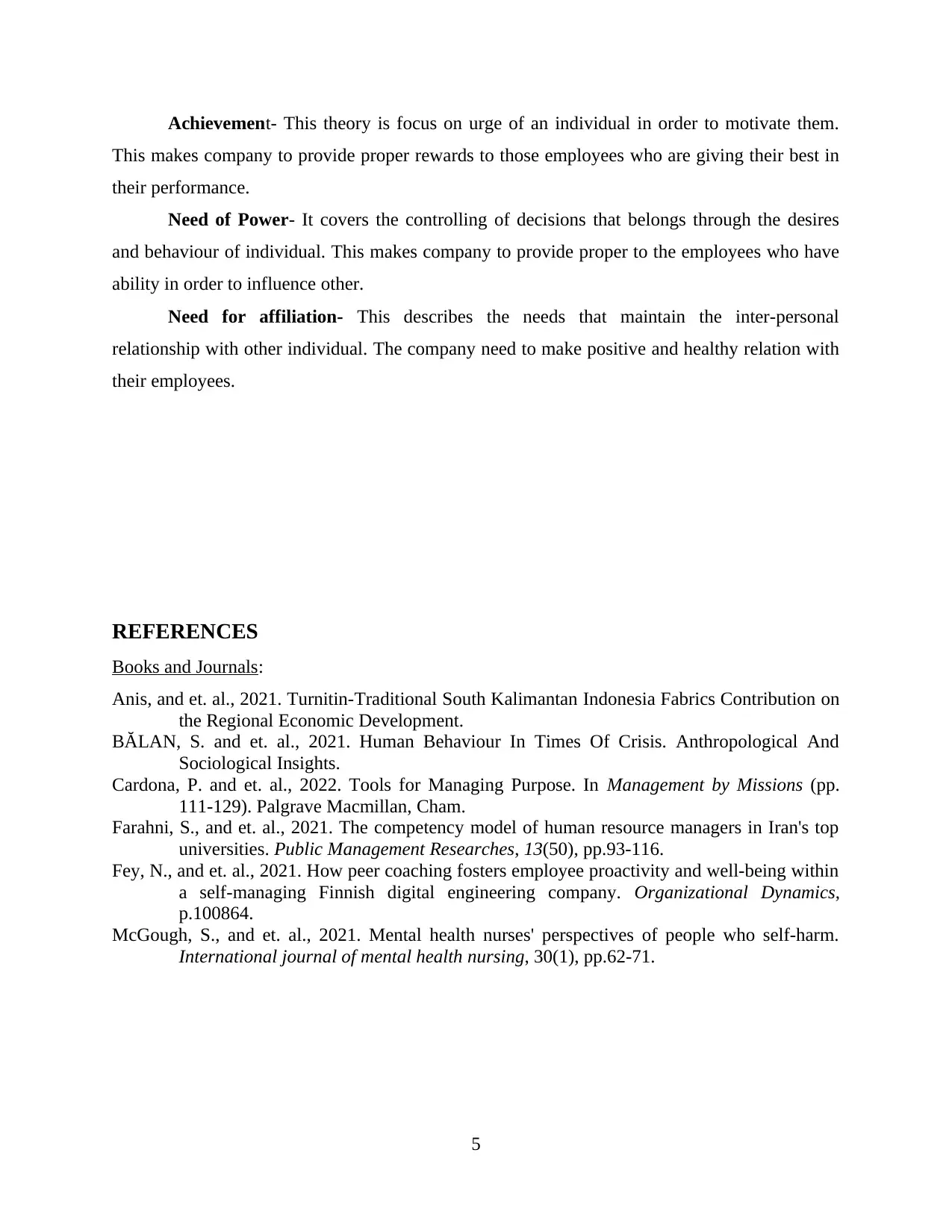
Achievement- This theory is focus on urge of an individual in order to motivate them.
This makes company to provide proper rewards to those employees who are giving their best in
their performance.
Need of Power- It covers the controlling of decisions that belongs through the desires
and behaviour of individual. This makes company to provide proper to the employees who have
ability in order to influence other.
Need for affiliation- This describes the needs that maintain the inter-personal
relationship with other individual. The company need to make positive and healthy relation with
their employees.
REFERENCES
Books and Journals:
Anis, and et. al., 2021. Turnitin-Traditional South Kalimantan Indonesia Fabrics Contribution on
the Regional Economic Development.
BĂLAN, S. and et. al., 2021. Human Behaviour In Times Of Crisis. Anthropological And
Sociological Insights.
Cardona, P. and et. al., 2022. Tools for Managing Purpose. In Management by Missions (pp.
111-129). Palgrave Macmillan, Cham.
Farahni, S., and et. al., 2021. The competency model of human resource managers in Iran's top
universities. Public Management Researches, 13(50), pp.93-116.
Fey, N., and et. al., 2021. How peer coaching fosters employee proactivity and well-being within
a self-managing Finnish digital engineering company. Organizational Dynamics,
p.100864.
McGough, S., and et. al., 2021. Mental health nurses' perspectives of people who self‐harm.
International journal of mental health nursing, 30(1), pp.62-71.
5
This makes company to provide proper rewards to those employees who are giving their best in
their performance.
Need of Power- It covers the controlling of decisions that belongs through the desires
and behaviour of individual. This makes company to provide proper to the employees who have
ability in order to influence other.
Need for affiliation- This describes the needs that maintain the inter-personal
relationship with other individual. The company need to make positive and healthy relation with
their employees.
REFERENCES
Books and Journals:
Anis, and et. al., 2021. Turnitin-Traditional South Kalimantan Indonesia Fabrics Contribution on
the Regional Economic Development.
BĂLAN, S. and et. al., 2021. Human Behaviour In Times Of Crisis. Anthropological And
Sociological Insights.
Cardona, P. and et. al., 2022. Tools for Managing Purpose. In Management by Missions (pp.
111-129). Palgrave Macmillan, Cham.
Farahni, S., and et. al., 2021. The competency model of human resource managers in Iran's top
universities. Public Management Researches, 13(50), pp.93-116.
Fey, N., and et. al., 2021. How peer coaching fosters employee proactivity and well-being within
a self-managing Finnish digital engineering company. Organizational Dynamics,
p.100864.
McGough, S., and et. al., 2021. Mental health nurses' perspectives of people who self‐harm.
International journal of mental health nursing, 30(1), pp.62-71.
5
1 out of 7
Related Documents
Your All-in-One AI-Powered Toolkit for Academic Success.
+13062052269
info@desklib.com
Available 24*7 on WhatsApp / Email
![[object Object]](/_next/static/media/star-bottom.7253800d.svg)
Unlock your academic potential
Copyright © 2020–2025 A2Z Services. All Rights Reserved. Developed and managed by ZUCOL.




